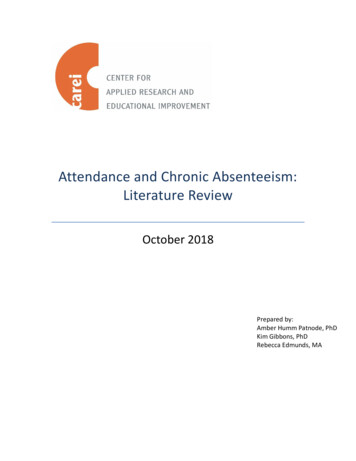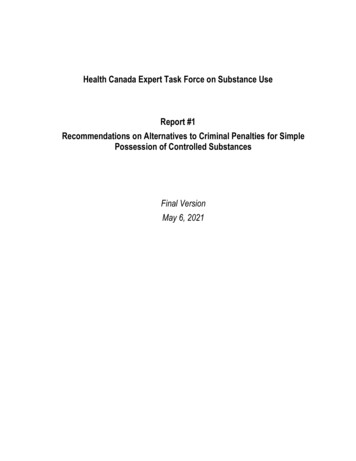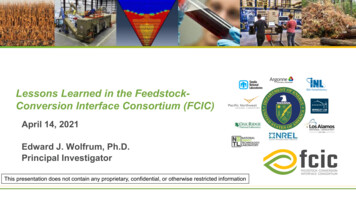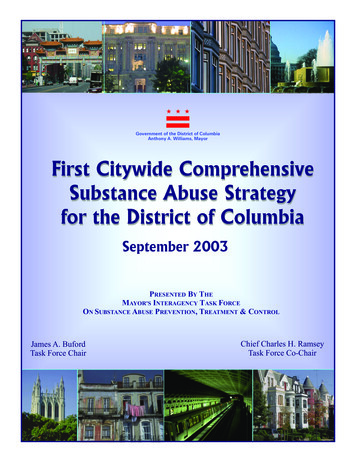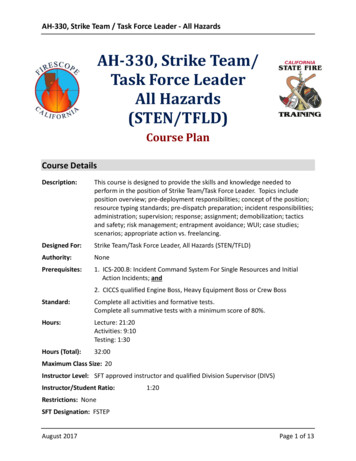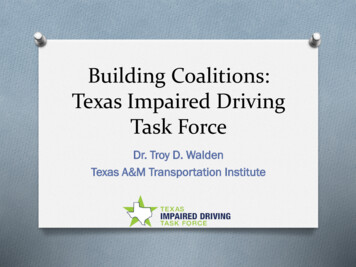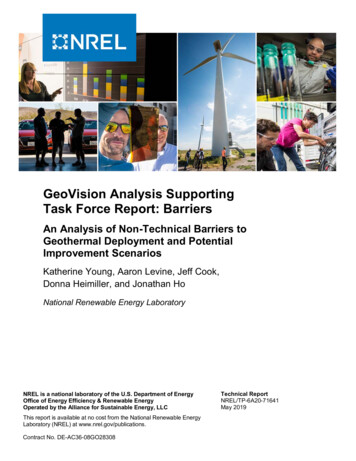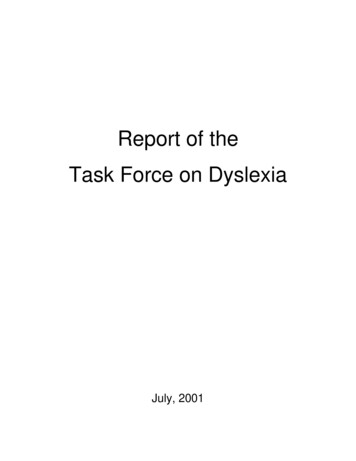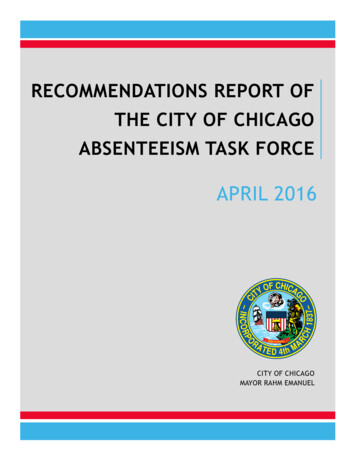
Transcription
RECOMMENDATIONS REPORT OFTHE CITY OF CHICAGOABSENTEEISM TASK FORCEAPRIL 2016CITY OF CHICAGOMAYOR RAHM EMANUEL
Report of the City of Chicago Absenteeism Task ForceTABLE OF CONTENTSLETTER TO THE MAYOR FROM THE CO-CHAIRS . 3ACKNOWLEDGEMENTS . 4TASK FORCE MEMBERSHIP . 5EXECUTIVE SUMMARY . 6BACKGROUND RESEARCH . 7THE CHALLENGE OF DEFINING ABSENTEEISM . 12BASELINE ANALYSIS OF CITY ABSENTEEISM . 14KEY ISSUES IDENTIFIED BY TASK FORCE . 17RECOMMENDATIONS . 19April 15, 20162
Report of the City of Chicago Absenteeism Task ForceLETTER TO THE MAYOR FROM THE CO-CHAIRSDear Mayor Emanuel,The Absenteeism Task Force submits the attached report detailing the results of our review ofabsenteeism in the City of Chicago workforce. The report lays out the scope and complexities ofabsenteeism and outlines recommendations for addressing these issues.This report builds on the work already done by many City departments and sister agencies, and drawson the suggestions and experiences of City departments, sister agencies, labor representatives, andelected officials, as well as research from national organizations and industry groups.The Task Force’s review found both successes in reducing absenteeism and opportunities to makefurther progress, Citywide and in individual departments. The findings and recommendations containedin this report provide a framework for implementing a comprehensive approach to reducingabsenteeism across the City workforce.Though an issue of enormous complexity, workforce absenteeism can be addressed with fundamentalreforms to increase the efficiency of City government, recapture lost worktime, and changeorganizational culture which will, ultimately, enhance services for residents across Chicago.Sincerely,Alderman Michele Smith43rd Ward, City of ChicagoAlexandra HoltDirector, Office of Budget and ManagementAbsenteeism Task Force Co-chairsApril 15, 20163
Report of the City of Chicago Absenteeism Task ForceACKNOWLEDGMENTSThe Absenteeism Task Force thanks the many individuals, including aldermen and labor representatives,whose contributions were critical to the work of the Task Force and the development of this report.We especially thank the staff from City of Chicago departments, who spent many hours speaking withthe Task Force about their policies, practices, systems, and challenges. Their ideas and suggestionsinformed many of the Task Force’s recommendations.The Task Force also acknowledges the Chicago Transit Authority, City Colleges of Chicago, Society forHuman Resource Management, and ideas42 for their contributions in supporting the work of the TaskForce.Finally, we would like to thank staff from the Mayor’s Office, Office of Budget and Management,Department of Finance, and the Department of Human Resources for coordinating the work of the TaskForce and leading the development of this report.April 15, 20164
Report of the City of Chicago Absenteeism Task ForceTASK FORCE MEMBERSHIPThe Task Force is a 20-member group including elected officials, labor representatives, and seniorleadership from multiple City departments.CO-CHAIRS Alderman Michele Smith, 43rd WardAlexandra Holt, Budget Director, City of ChicagoCITY COUNCIL Alderman Pat Dowell, 3rd WardAlderman Pat O’Connor, 40th WardAlderman Matthew O’Shea, 19th WardAlderman Ariel Reboyras, 30th WardBen Winick, Director, Council Office of Financial AnalysisLABOR Matt Brandon, SEIU 73James Ellis, Laborers 1001Jo Patton, AFSCME 31DEPARTMENTS Randy Conner, First Deputy Commissioner, Department of TransportationCarol Hamburger, Managing Deputy Comptroller, Department of FinanceGerald Hollowell, Deputy Director, Office of Emergency Management & CommunicationsDon O’Malley, Director of Labor Relations, Department of LawChris Owen, First Deputy Commissioner, Department of Human ResourcesKurt Peterson, First Deputy Budget Director, Office of Budget and ManagementAnnette Plattner, Deputy Director, Office of Budget and ManagementJennifer Ross, Director of Personnel, Chicago Public LibraryMarisol Santiago, Director of Administration, Department of Water ManagementJohn Tully, First Deputy Commissioner, Department of Streets and SanitationIn addition to its members, the Task Force drew on the expertise of other key participants, including:John Arvetis, Department of Finance; Michael Garrity, Department of Law; Nicole Hayes, Laborers 1001;and Helen Thornton, AFSCME 31.April 15, 20165
Report of the City of Chicago Absenteeism Task ForceEXECUTIVE SUMMARYOn October 28, 2015, the City Council and Mayor Emanuel approved a resolution calling for theestablishment of an Absenteeism Task Force (Task Force) focused on studying and addressing City ofChicago (City) employee absenteeism. 1The Task Force was charged with the following goals: To examine the causes and extent of absenteeism among City employees, with a view towardadopting recommendations to ameliorate the problem, including changes to law, policies, andprocedures. To make initial recommendations to the Mayor within 120 days from the formation of the TaskForce. To arrange for the online posting of City employee absenteeism data, organized by departmentand updated on a quarterly basis, for aldermanic and public review.The Task Force convened a series of meetings to examine the causes of and consider solutions forabsenteeism among City employees. Each meeting focused on a set of topics, including the definition ofabsenteeism; national benchmarks; the importance of timekeeping codes, reporting, and training; sisteragency approaches to managing absenteeism; and personnel rules and protocols. The Task Force alsoheld one-on-one sessions with representatives of City departments and conducted a survey to solicitinput on key concerns and solutions.Through this process, the Task Force identified several key areas for improvement: Updating the City’s timekeeping system and procedures to ensure that protocols are consistentacross departments and the City has more accurate attendance records for all its employees. Updating the City’s time and attendance policies to ensure that employees and supervisorsunderstand expectations, allowing the City to hold employees and management accountable. Providing management with tools and training to more effectively monitor employeeattendance. Expanding employee orientation and training to clearly communicate attendance expectationsand reinforce organizational values.Effective management of absenteeism requires the collaboration of multiple stakeholders, includingemployees, supervisors, management, and labor representatives. Some of the proposed1A copy of the resolution is included in Appendix A.April 15, 20166
Report of the City of Chicago Absenteeism Task Forcerecommendations will require that the City work with labor representatives through the collectivebargaining process. By instituting the reforms contained in this report, the City aims to reduceabsenteeism while increasing the efficiency of City operations and the value for Chicago’s taxpayers.This report summarizes the deliberations and recommendations of the Task Force’s members. It reflectsthe general consensus of the members; however, individual members may have differing views on thedetails and recommendations contained in this report.BACKGROUND RESEARCHAbsenteeism is an issue faced by private and public sector employers alike. The Task Force reviewedliterature addressing the costs, productivity impacts, and causes of absenteeism.2 It also consulted withideas42, the Society for Human Resource Management (SHRM), and sister agencies on best practices.These reports and consultations largely confirmed the information shared by and gathered from Citydepartments and labor representatives.This section provides high level background information on absenteeism in general, including how ratesare calculated, its impact, and the associated challenges of accurate timekeeping. It also summarizesrecent absenteeism initiatives undertaken by the City and its sister agencies via three case studies thathave informed our recommendations.ABSENTEEISM RATESRates of absenteeism or lost worktime vary by industry type, by private versus public sector, and withinthe public sector by level of government. The U.S. Bureau of Labor Statistics (BLS) publishes data onabsence rates and lost worktime rates among various industries and employer types. These rates includeboth paid and unpaid time off work. The BLS lost worktime rates are summarized in Figure 1.0 (Source:BLS, 2015).3 Apart from the BLS data, absenteeism benchmarks for municipalities are scant and themeasures vary from one local government entity to the next.2Additional background information can be found in a variety of white papers including: (i) “Limited Visibility: The Public SectorAbsence Management Challenge”, Kronos; (ii) “The Latest Front in the Battle Against Wasteful Spending”, Governing; (iii)“Absenteeism: The Bottom-Line Killer”, Circadian; and (iv) “Total Financial Impact of Employee Absences in the U.S.”, Kronosand Society for Human Resource Management.3The BLS defines lost worktime rate as the hours absent as a percent of hours usually worked. Absences are defined asinstances when persons who usually work 35 hours or more per week (full time) worked less than 35 hours for one of thefollowing reasons: own illness, injury or medical problems; child care problems; other family or personal obligations; civic ormilitary duty; and maternity or paternity leave. Excluded are vacation days, personal days, holidays and other situations (suchas labor disputes, bad weather or other reasons). See http://www.bls.gov/cps/cpsaat47.htmApril 15, 20167
Report of the City of Chicago Absenteeism Task ForceFigure 1.0 Lost worktime rates by sector, industryTotal Employed1.5%Public Sector1.8%Private Sector1.4%State Government1.8%Local Government1.7%Federal Government2.0%Office & Admin Support1.8%Legal0.9%Installation, Maintenance & Repair1.5%Healthcare Practitioner & Technical1.9%Construction & Extraction1.3%Computer & Mathematical1.1%Business & Financial Operations0.0%1.2%0.5%1.0%1.5%2.0%2.5%IMPACT OF ABSENTEEISMAbsenteeism in the workplace has both direct and indirect costs that impact operations andproductivity. These include, but are not limited to, overtime and payroll costs, diminished productivity,missed service targets, and low employee morale. Figure 2.0 summarizes absenteeism-related costs.The direct costs associated with absenteeism can lead organizations to accrue significant cost overrunsassociated with unanticipated payroll costs. For many organizations, one of the key costs of employeeabsences is replacement workers or workers hired on overtime in place of employees who are not atwork. For service organizations, including local governments, high rates of absenteeism may impact theprovision of basic services. When an employee is absent, there may not be sufficient staff to meetservice or project deadlines.April 15, 20168
Report of the City of Chicago Absenteeism Task ForceAdditionally, when absenteeism is widespread or the same employee is routinely off work, the workloadincreases for other employees who must provide coverage. Habitual absenteeism, when unchecked, cannegatively impact organizational culture, erode confidence in management, diminish productivity, andresult in heightened levels of employee burnout and/or turnover.Figure 2.0 Direct and indirect costs of absenteeismDIRECTFINANCIAL Payroll costsOvertime costsWorker replacement costsCost of decreased service useSERVICE RELATED /QUALITATIVE Loss of serviceSafety concernsQuality of serviceINDIRECT Productivity loss (individual andorganizational)Administrative costsManagement time lossLow moraleReduced trust/increaseddissatisfaction with servicesHigher turnoverTIME AND ATTENDANCE RECORDKEEPINGMost organizations utilize a system for establishing employee work hours (e.g. shifts) and recordingwhen employees start and stop work along with any exceptions such as vacations, sick leave or personaldays. Incomplete and inaccurate recordkeeping impedes monitoring and controlling of employeeabsenteeism and may increase both indirect and direct costs to the employer. Inaccurate time trackingoften results from manual, or paper tracking, of employee time records where data entry errors tend tobe higher than automated systems. Manual tracking, whether used exclusively or in conjunction withautomated systems, relies on self-reporting by employees and requires managers to monitor thetimeliness and accuracy of paper forms. Coding errors that occur when manual exceptions are enteredinto the payroll system compounds the inaccuracy of the timekeeping records. These inaccuracies,intended or accidental, result in direct costs to employers in the form of payment for time not workedand inaccurate vacation payouts upon separation. These impacts are in addition to the costs associatedwith the staff needed to manage a paper-based system in the first place.Manual systems make it difficult for managers to track absenteeism in a consistent manner and mayallow for problems to go undetected. Automated timekeeping systems provide enhanced monitoringand minimize errors, although most automated systems have manual processes, such as for codingexceptions. Careful monitoring of time is required regardless of the level of system automation.April 15, 20169
Report of the City of Chicago Absenteeism Task ForceThe City’s timekeeping system makes use of biometric time clocks for capturing employee in and outswipes (e.g. time punches).4 The biometric clocks use hand geometry technology designed to protectindividuals and companies from fraudulent transactions by ensuring that employees can only swipe infor themselves, and nobody else. The captured data feeds into the Chicago Automated Time andAttendance (CATA) system, which is used for tracking time and attendance and generating payroll.Various CATA codes are entered manually to record time exceptions such as employee vacations, sickdays, unexcused absences, and missed swipes. Such codes are only entered by authorized individualssuch as supervisors and timekeepers.CITY AND SISTER AGENCY ABSENTEEISM INITIATIVESPer the Mayor’s directive, in 2013 an internal workgroup was formed with City and sister agencyrepresentatives to compile absenteeism data and share best practices aimed at reducing absenteeismand negating adverse operational impacts. The success stories shared by the Chicago Transit Authority,City Colleges of Chicago, and the City’s Department of Fleet and Facility Management are presentedbelow and provided insight to the Task Force in the development of its recommendations.Department of Fleet and Facility Management Case StudyThe Department of General Services and the Department of Fleet Management were consolidatedbeginning in the summer 2011 with full integration into the Department of Fleet and FacilityManagement (2FM) on January 1, 2012.Each of the departments that formed 2FM had a different definition of absenteeism, along withdifferent rules and protocols. Certain management practices had developed over time, includingpermitting employees to take numerous “no pay days” and unchecked tardiness. Timekeepingprocedures and codes were inconsistent as were expectations and controls for employee swipes andtime edits. While some divisions were managing absenteeism prior to the merger, many wereindifferent to the negative effects that absenteeism had on operations.To address these issues, several reforms were initiated to improve management oversight andstreamline and codify absence codes. These included the development of a comprehensive ‘Guide forUsing CATA Codes’ and a revised Edit Form, used to manually record time when an employee failed to orwas unable to swipe. These changes ensured consistent and accurate time and attendance records. Thedepartment’s expectations were also made clear and a robust training initiative ensured thatsupervisors understood their role in and responsibility for effectively managing absenteeism.4The Fire and Police Departments currently utilize paper-based timekeeping systems. Both departments will transition to theCity’s automated CATA system by Winter 2018 – a timeline that accounts for operational and technological considerations.April 15, 201610
Report of the City of Chicago Absenteeism Task Force2FM established “absenteeism triggers” to flag potential rule violations. These triggers were reported tosupervisors on a monthly basis and bureau-wide reports were sent to senior management. Progressivediscipline was consistently applied whenever triggers and the circumstances of absenteeism warrantedaction. Senior leadership routinely reviewed absenteeism data at the employee level and keyperformance indicators were reported to and reviewed by the Commissioner on a monthly basis.In 2012, the department recorded nearly 12,000 lost work hours due to overt unpaid absenteeism,which was an average of each employee being absent for nearly 11.5 hours during the year (in additionto paid time off).5 By 2015, the department reduced overt absenteeism to approximately 3,450 lostwork hours; an average of each employee being absent for only 3.5 hours during the year. The overtabsence rate fell from .57% in 2012 to only .18% in 2015, representing a 65% decrease in overtabsenteeism.Chicago Transit Authority Case StudyIn 2011, the Chicago Transit Authority (CTA) embarked on an initiative to study and addressabsenteeism. It was determined that the tracking and collecting of absenteeism data was inconsistentand incomplete, and a collection template and aggregation model was built to ensure accountability,accuracy, completeness, and consistency.An in-depth analysis was conducted which included historical and cross-department comparisons; thisanalysis helped to identify absence problem areas and patterns across the agency. Several mechanismswere developed to communicate the results of the analysis, including: a monthly report with views intoeach department, location, function, position, and absence type; department-level absenteeismdashboards; visual displays to communicate detailed absenteeism results to personnel along withcomparisons to other CTA locations; and “targeted lists” which utilized predictive modeling to findrepeat users on specific days where absenteeism rates have historically spiked.In addition, policies were clarified and training was provided to facilitate consistent application ofpolicies and procedures, including disciplinary guidelines for absenteeism. A new employeemanagement system was installed which allowed an increased focus on workers compensation and“return to work” programs. A new Leave Management Department was also established to streamlineand consolidate administrative tasks, and a third party administrator was engaged to more effectivelymanage and monitor FMLA.As a result of these efforts, the CTA showed a 19.4% decrease in its absenteeism rate from 2011 through2013 accounting for approximately 21,000 fewer days taken.6 The CTA has maintained that level through2016.56Overt absenteeism includes unexcused absences and unpaid sick leave.The CTA defines absenteeism as sick days, FMLA, injured on duty, absence without leave, and late arrivals or “misses”.April 15, 201611
Report of the City of Chicago Absenteeism Task ForceCity Colleges of Chicago Case StudyIn order to improve efficiency, reduce payroll errors and more accurately track employee time andmanage absenteeism, in 2014 the City Colleges of Chicago (CCC) instituted an electronic time andattendance system called CCC Works. The automated time and attendance system uses time clocks anda web interface system to provide real-time access to time and attendance records. In addition, thisautomated and paperless time sheet system provides employees and managers a faster and moreaccurate way to record and manage time off requests and leave balances.CCC broadly communicated its work rules contained in the Employee Handbook to provide a clearerdefinition of absenteeism and consequences for violations. A robust employee and manager trainingprogram was also implemented along with the enhanced communication efforts that routinely engagedemployees via attendance-related email blasts, policy flyers and proactive individual notifications whenemployees were nearing a violation. Progressive discipline was consistently applied to addressproblems. Reports were generated for senior management on key performance indicators to inform theteam of various metrics.In July of 2013 prior to the implementation of CCCWorks, CCC had an absenteeism rate of 1.6%. Duringthe initial stages of monitoring post-implementation of CCC Works, the absence rate increased andpeaked at 3.8% in January 2015 as a result of more accurate exception time reporting, including sick andother time away from work, accurate timekeeping, and stricter adherence to attendance policies. SinceJanuary 2015, the absenteeism rate declined and has held steady at between 2.5-3.0%.7THE CHALLENGE OF DEFINING ABSENTEEISMAn absence occurs whenever an employee who was scheduled to work does not work, regardless ofreason. While it is expected that workers will miss a certain number of workdays each year, excessiveabsences have a negative impact on operations, productivity, service levels and finances. Employeesmiss work for any number of reasons, some of which are legitimate while others are not. While mostemployees are afforded excused time off, primarily in the form of vacation and sick leave, habitualabsenteeism is more blatant, disruptive, and costly.The causes of absenteeism are many and generally include the following: burnout, stress, and fatigue;childcare and eldercare; depression and mental health issues; disengagement and feeing undervalued;illness and injury (self or family member); sporting events, national events and weather events;extended weekends (days off before and after the scheduled “weekend” and holidays); and entitlementmentality.7The CCC defines absenteeism as the failure of an employee to report to a scheduled shift. Absenteeism includes sick days(paid and unpaid), call offs, no call/no shows, and days absent without paid time.April 15, 201612
Report of the City of Chicago Absenteeism Task ForceSHRM has defined absenteeism as the failure of an employee to report for work when the employee isscheduled to work. Furthermore, they distinguish between legitimate and non-legitimate absences viathe following methodology: 8 Excused Absence. An excused absence occurs when all four of the following conditions are met:a) the employee provides sufficient notice to his or her supervisor, b) the reason is foundcredible or acceptable by his or her supervisor, c) such absence request is approved by his or hersupervisor, and d) the employee has sufficient accrued paid time off (PTO) to cover suchabsence. Unexcused Absence. An unexcused absence occurs when one of the four conditions notedabove is not met.Excused absenteeism is predominantly driven by employee-benefit packages that include paid vacation,sick leave, and personal days, as well as parental, bereavement, jury and/or medical leave (including therequirements of the federal Family and Medical Leave Act (FMLA)). Additionally, leave due to an on-thejob injury or for disciplinary proceedings such as suspensions or paid administrative leave are consideredplanned and/or excused, even if undesirable. Absenteeism definitions, policies and benchmarks vary inwhich types of absences are included and how they are categorized (unexcused vs excused, paid vsunpaid, planned vs unplanned). Further, the way in which disability, bereavement, military, jury,disciplinary, and other types of administrative leaves are quantified and categorized also varies. Thesevariations make it difficult to set benchmarks based on external, nationwide standards or on othergovernments or entities.The definition of absenteeism developed by the Task Force is outlined below in the Recommendationssection.MEASURING ABSENTEEISMAfter defining an organizational standard of absenteeism, there are several methods for measuringabsenteeism. They include:8 Absence Rate: Ratio of workers with absences to total full-time wage and salary employment Lost Worktime Rate: Hours absent as a percent of hours usually worked Unscheduled Absence Rate: Share of workforce missing from work at any given time due tounscheduled absence Mean Absence Rate: Total paid-unscheduled hours divided by total paid-productive hoursSociety for Human Resource Management, Attendance Policy #2, May, 30, 2014.April 15, 201613
Report of the City of Chicago Absenteeism Task ForceGiven the varying definitions of absenteeism and measurement options, benchmarks are only helpfulwhen an organization adapts their definition of absenteeism to that of the benchmark. As previouslynoted in this report, the BLS provides absenteeism data by occupation and industry, including the publicsector, in the form of both an absence rate and lost worktime rate. The public dashboard discussed inthe Recommendations section and posted in Appendix B uses the lost worktime rate for measuringabsenteeism. It should be noted, however, that the BLS data is compiled from the Current PopulationSurvey, which includes a monthly sample survey of 60,000 households (see footnote 3); how theseabsences are categorized and tabulated and how they correlate to the City’s timekeeping codes isimprecise.BASELINE ANALYSIS OF CITY ABSENTEEISMANALYSIS OF CURRENT DATAThe Office of Budget and Management and the Department of Finance conducted a baseline analysis ofCity absenteeism using data from the CATA system. Figure 3.0 displays citywide absenteeism bycategory for 2015 data.Figure 3.0 2015 Citywide absenteeism categoriesSick Leave Paid17%FMLA7%Other Excused6%OvertAbsenteeism5%Vacation/Personal Day/Comp-time59%Disability/Medical Leave4%Leave of Absence2%This analysis showed that earned leave, including vacation, personal days and compensatory time, madeup the majority of absences (59%), followed by paid sick leave (17%), FMLA (7%), other excused (6%),overt absenteeism (5%), disability and medical leave (4%), and leaves of absence (2%). The ‘otherexcused’ category includes multiple types of leave such as bereavement, jury duty, union business,military leave, and administrative leave, each approximately 1% or less of all City employee leave. The‘overt absenteeism’ category includes unpaid sick leave and unexcused absences.April 15, 201614
Report of the City of Chicago Absenteeism Task ForceBecause vacation, personal days, and compensatory time are generally taken as a right and thereforeare not considered “absenteeism” by generally accepted standards, these categories of leave were notthe focus of our study. Rather, the Task Force considered the remaining forms of absenteeism.At the other extreme is “overt absenteeism,” which includes unpaid sick leave and unexcused absences.Figure 3.1 displays percentages of the overt absences. Overt absences account for about 12% to 14% ofthe overall lost worktime.Figure 3.1 2015 Overt absences by typeUnexcusedAbsence37%Sick Unpaid63%Figure 3.2 displays the lost worktime rates for the City as a whole. It should be noted, however, that thisanalysis was impacted by significant variations in timekeeping policies and practices across Citydepartments. The criteria used to code absences in the CATA system are not consistent acrossdepartments. One department may code an absence differently than another department, anddepartments may even differ in what qualifies as an absence. While the aggregate absence data isaccurate, the designations into the noted categories are less precise. These variations make it difficult toobtain an accurate picture of absenteeism across the City.9The Task Force recognizes that the City’s lost worktime rates are higher than the national average; somepart of the difference may be due to more generous paid leave provisions in the City than in otherorganizations.9The dataset does not include the Chicago Police Department or the Chicago Fire Department, as those departments have yetto fully transition to the City’s automated time and attendance system.April 15, 201615
Report of the City of Chicago Absenteeism Task ForceFigure 3.2 Citywide lost worktime (2014 & 2015)DEPARTMENTAL SURVEYIn addition to the quantitative analysis of existing absenteeism data, meetings were held with seniorstaff from City departments. Each meeting included a discussion about perceived and known problemareas and recent reform initiatives, as well as a review of departmental timekeeping protocols, time andattendance policies and procedures, and disciplinary triggers.This survey revealed several challenges with managing absenteeism largely impacted by policy,procedure, and work rule variations. Most notably, the lack of consistent City-wide policies andaccountability standards adversely impacts absenteeism management at the d
Chicago (City) employee absenteeism.1 The Task Force was charged with the following goals: To examine the causes and extent of absenteeism among City employees, with a view toward . or paper tracking, of employee time records where data entry errors tend to be higher than automated systems. Manual tracking, whether used exclusively or in .
